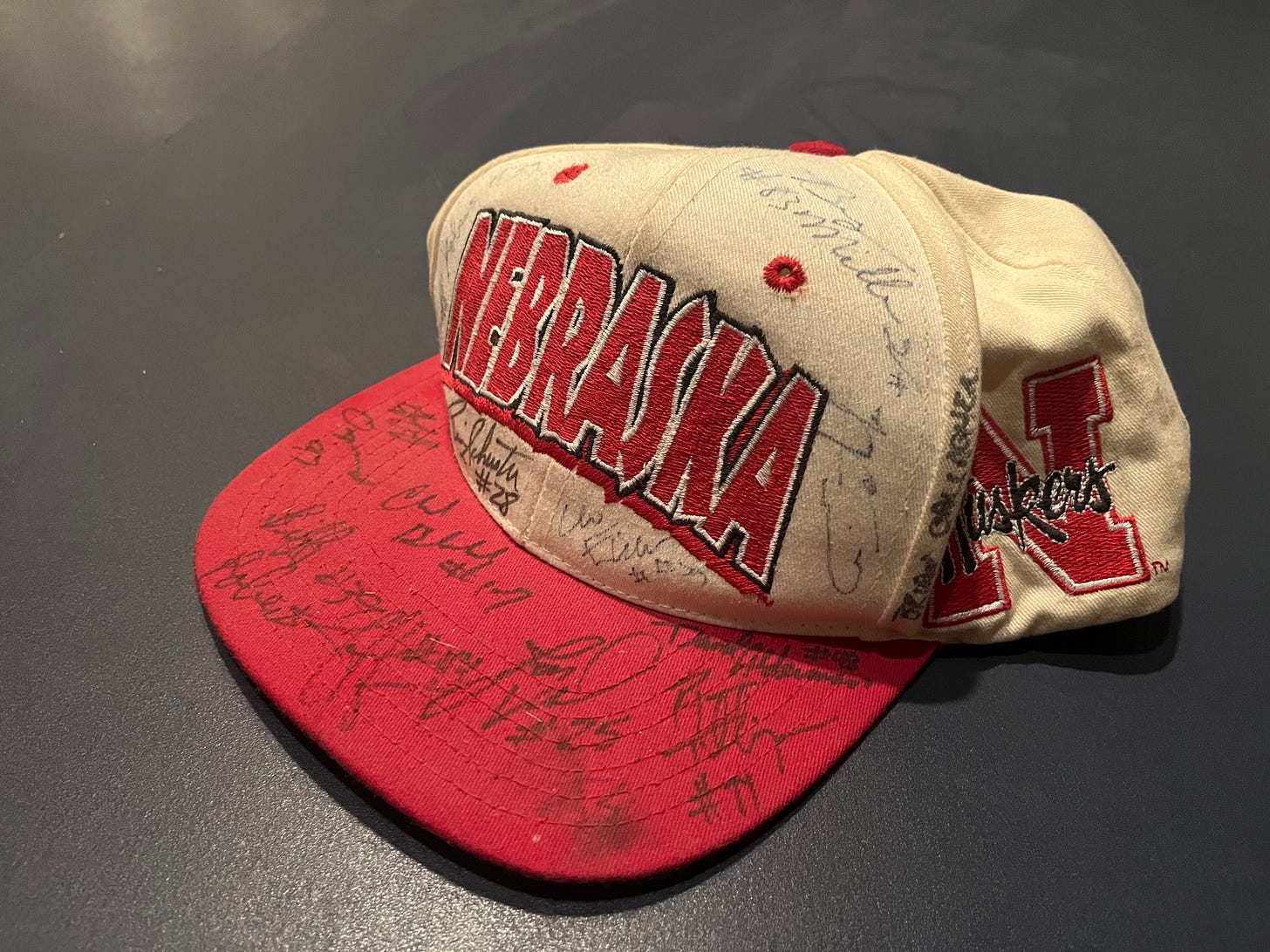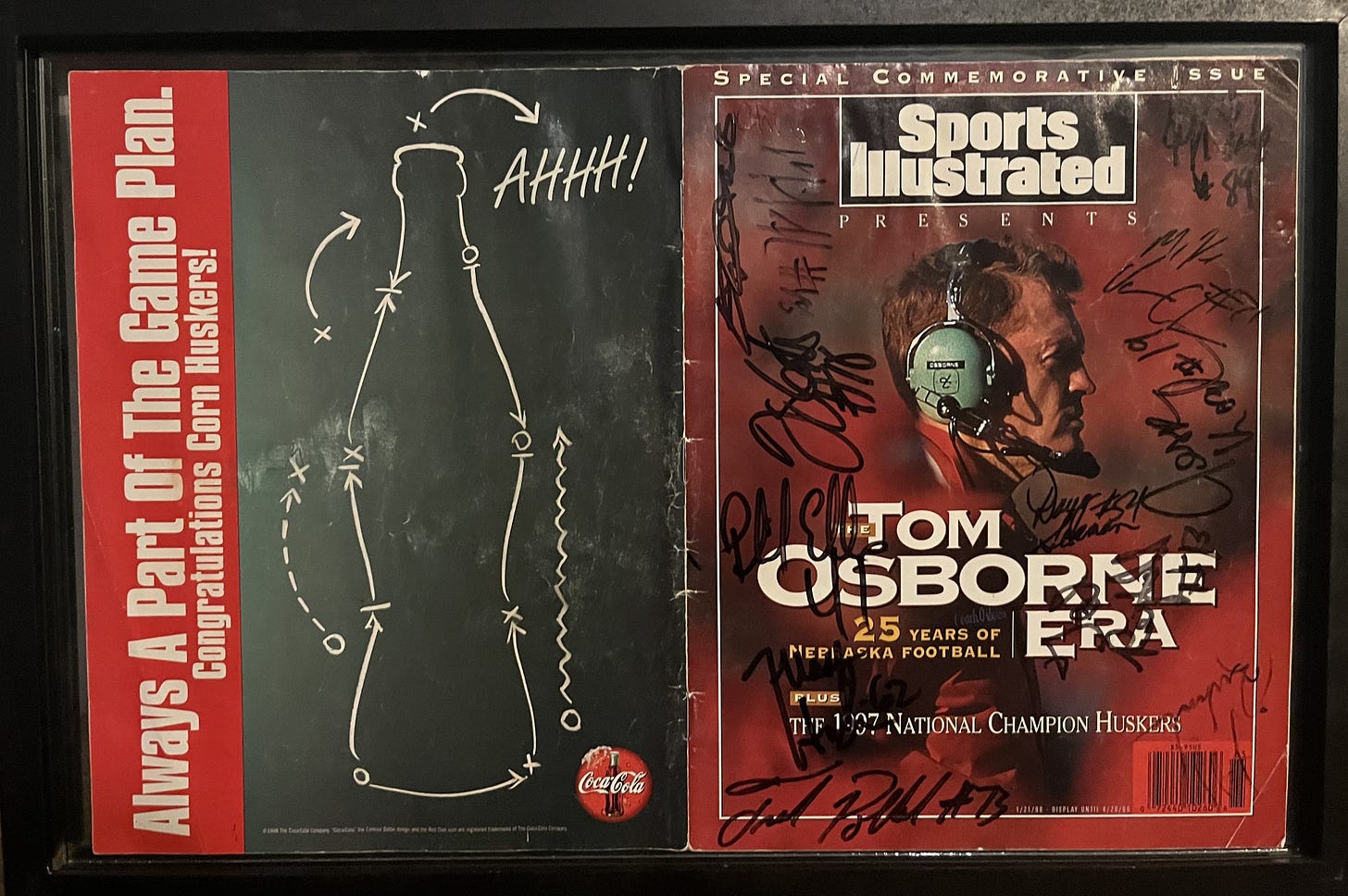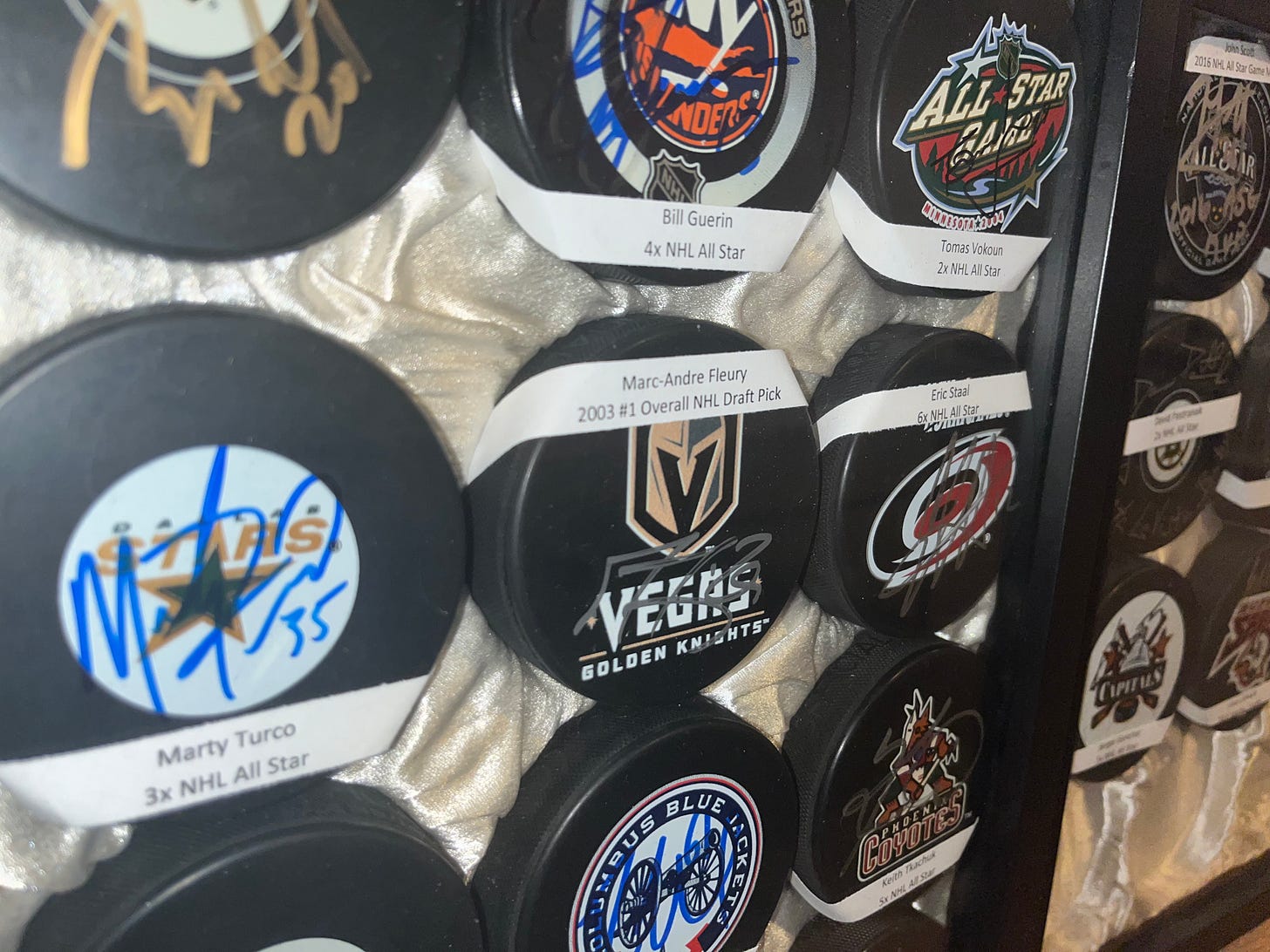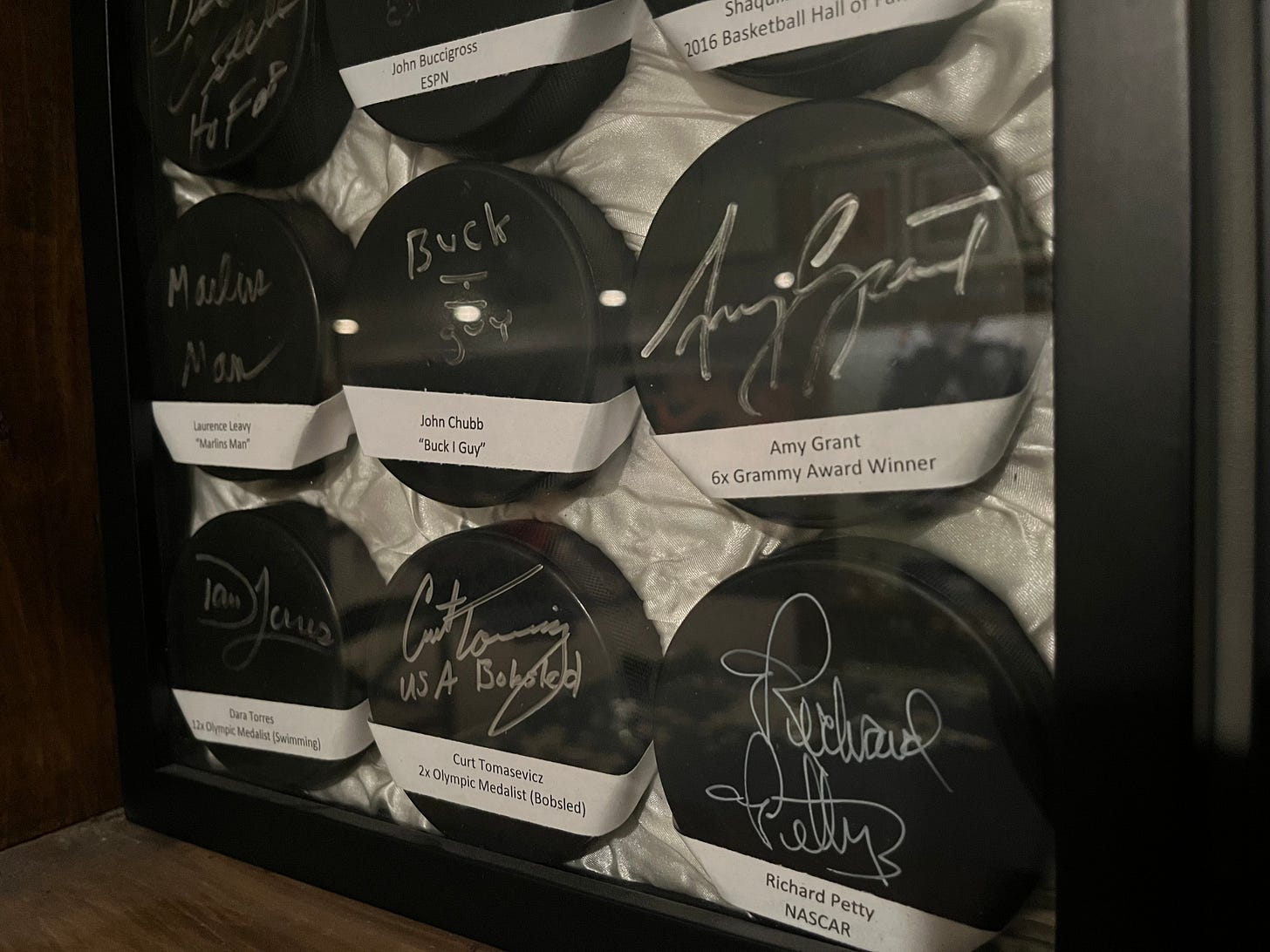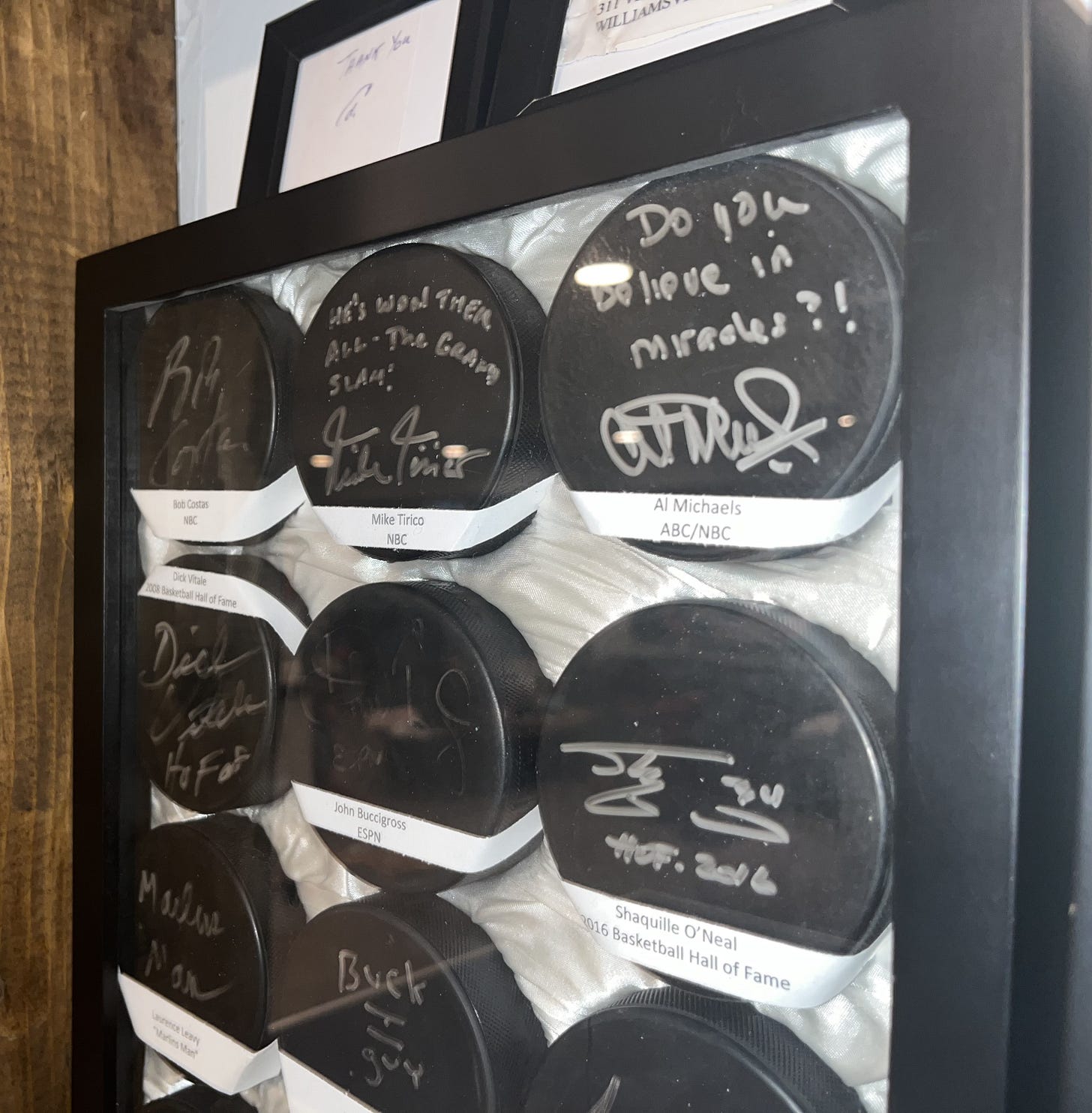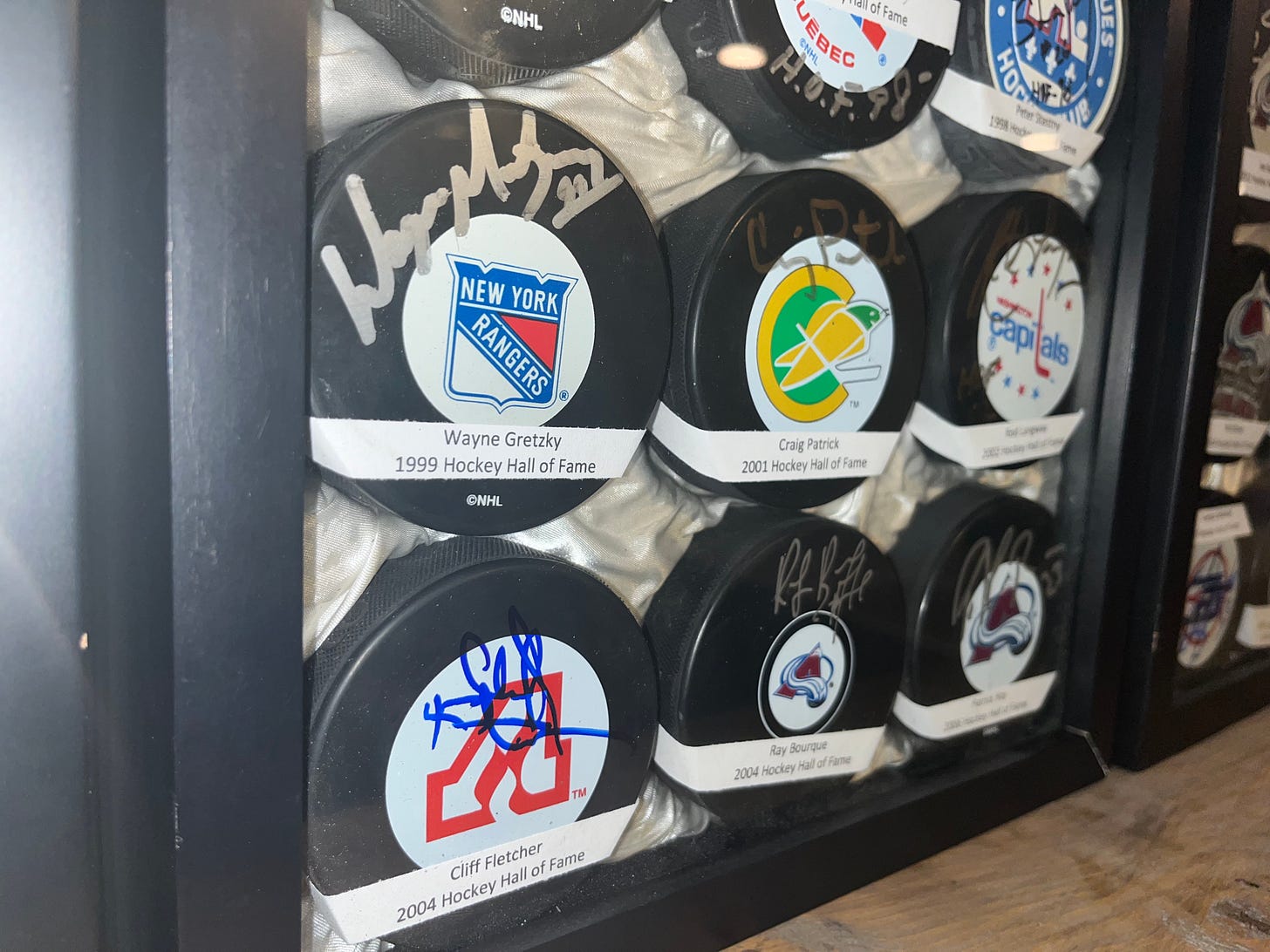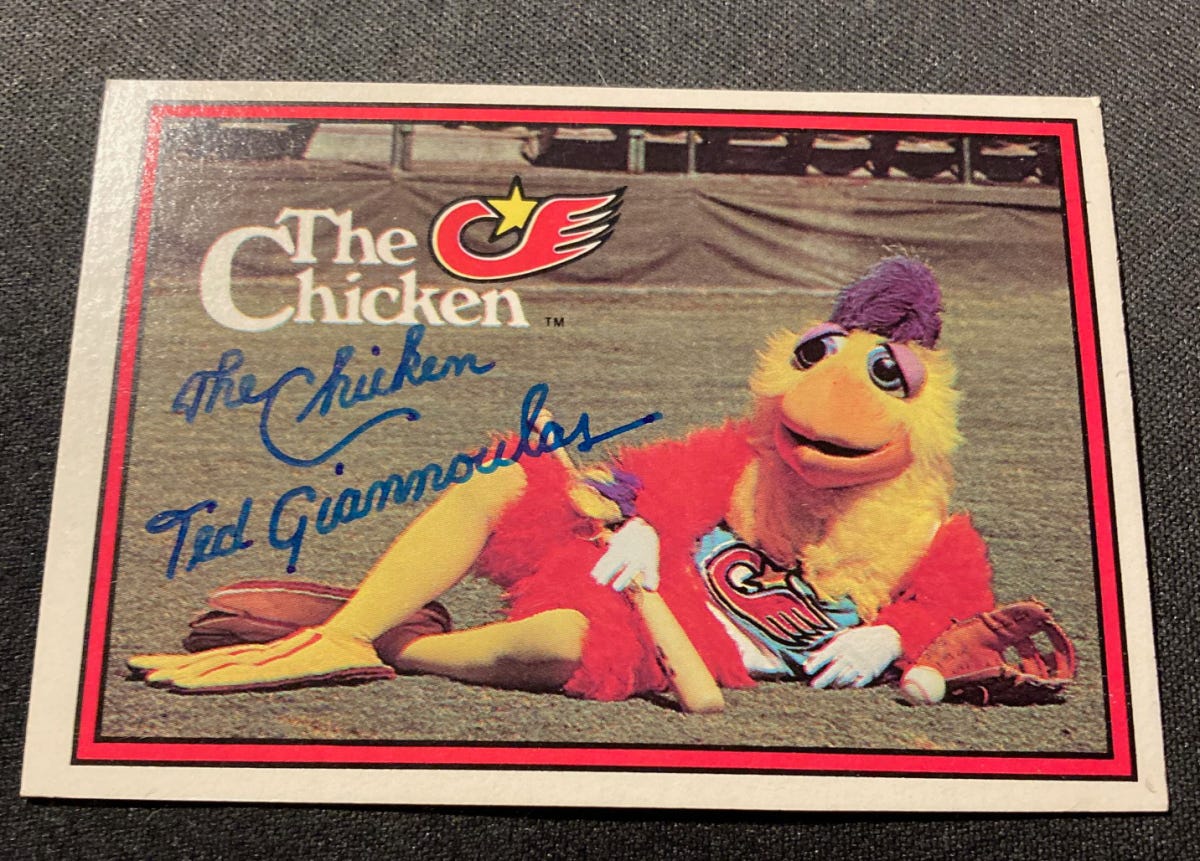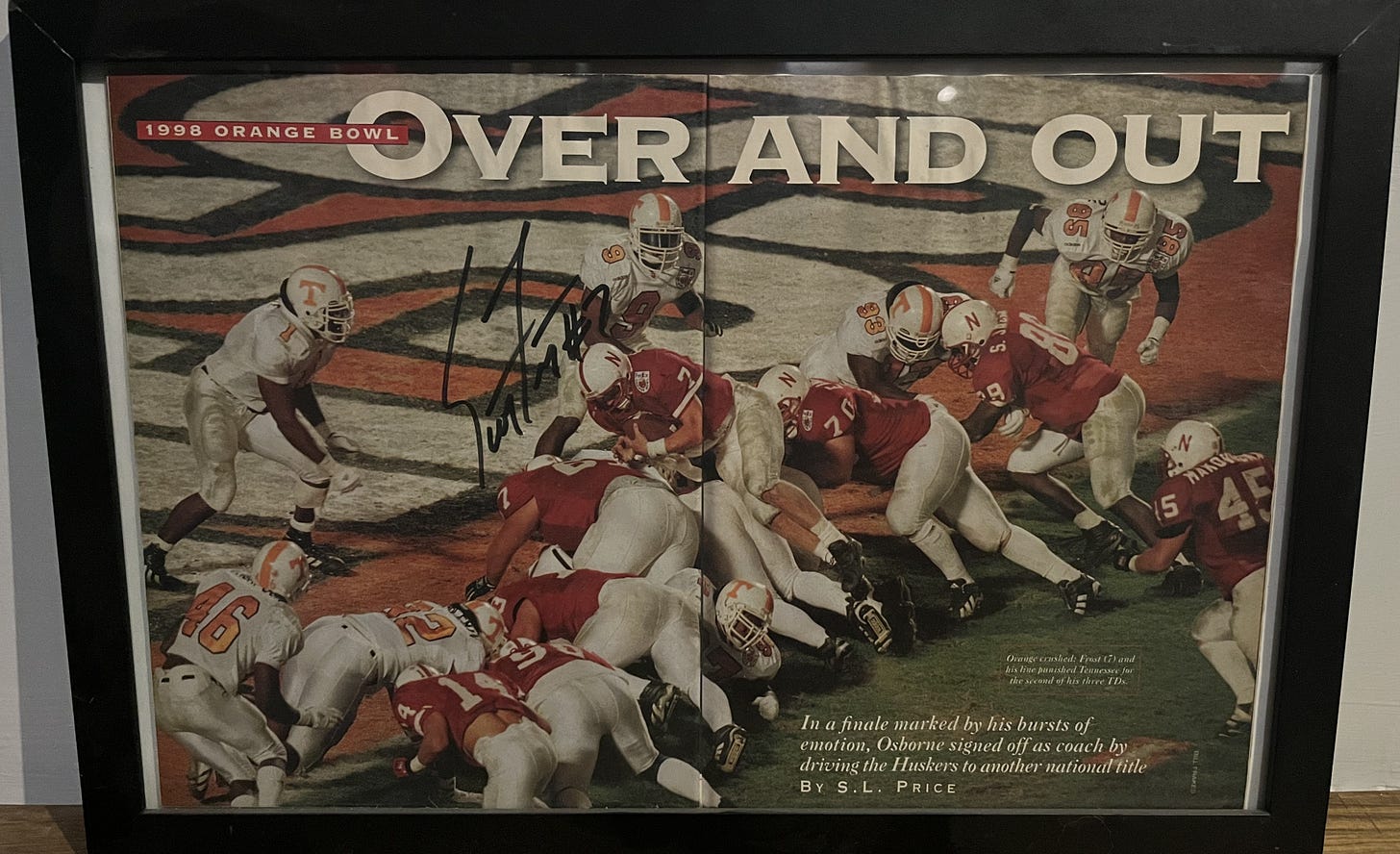Growing up in Central Nebraska, one doesn't simply 'go' watch your favorite team. The closest professional sports cities are Kansas City or Denver, a solid five or six-hour car ride away. Just close enough to hit cable blackout restrictions and just far enough to have absolutely nothing to do with the broader day-to-day culture that accompanies sports and their local fanbases. Growing up in Central Nebraska, you probably didn't even like those KC or Denver teams anyway. Picking a favorite was like falling in love. Some found their sports romance through a casual first date watching a game as an adolescent. Others just really liked the way those athletic bodies looked wearing a particular color scheme. And then many of us were forced against our will into an arranged marriage by our parents and are now forever trapped in an abusive relationship with a Boston franchise.
The uniting factor in all of this was a single word, often embroidered across a Starter Jacket or tattooed in faded red ink on the back of the flabby calf of that one kid in your class's dad: HUSKERS.
We were still too far away to actually attend a Husker football game, and most of our parents weren’t in an income bracket that could afford tickets anyway, but on Saturdays we all worshipped together as one. We spoke in a form of tongues that could only be understood by those blessed by the same conversion experience — triple option, Blackshirts, the Pipeline, fumblerooski, Fullback, fuck Texas — and as we watched a goal line stand our charismatic bodily contortions were as synchronized as the day of Pentecost.
We may never be picked to be the host site of a Super Bowl, but us small town Nebraskans had all we needed in the form of 18-to-22-year-olds playing an hour-and-a-half away in the State Capital.
●●●
I went to my first Husker game on November 15, 1997. It was Senior Day and the legendary Tom Osborne's last home game. We were playing Big XII bottom feeder Iowa State and I was able to sneak into the game with my dad and brothers as they volunteered to be ticket ushers. Memorial Stadium began using Boy Scouts to perform this task, likely so they didn't have to pay them, but it allowed a lot of us dreamers to take our first ever pilgrimage to Mecca.
We weren’t given proper tickets and our seats were folding chairs set up behind the visitor’s bench. As a seven-year-old craning to see over the top of a bunch of college athletes, I was completely disappointed in my viewing experience. But not in my game day experience. I was able to track down a couple of torn stubs near the garbage cans and was so in awe of Memorial Stadium that I kept a paper towel from the bathroom. Anything from this site was sacred.
●●●
The closest I ever came to seeing my favorite team play at my hometown was an exhibition basketball game for charity. Shortly after winning the National Championship, a bunch of third string long snappers and offensive linemen came to Grand Island to play a pick-up basketball game at Walnut Middle School— against a team of local businessmen who had the type of connections to be asked to play a pick-up basketball game against a bunch of third string long snappers and offensive lineman.
I didn't know a single name on the roster of Huskers, but it didn't matter. I was fucking pumped.
●●●
My mom took my brothers and I to Skagway Grocery to buy something from their Husker section to get autographed. We landed on matching snapback trucker hats. I spent the entire half-time and post-game running down every member of the Husker team and making them sign my new most-treasured possession. This was my first introduction to autographs.
There was something thrilling about desperately sticking out my cotton trucker hat amongst a sea of fellow autograph seekers and the visceral thrill when my item was chosen. I spent hours admiring each signature, selecting my favorites and pointing out their beauty to my older brothers. We used extra paper programs from the event to make our own autographs from the names of family members, and I added these pamphlets to my signature collection as well.
The signatures on the programs were worthless and illegible, but so were the ones on my hat. But they were worth something to me. And they looked really freaking cool. Next year the event returned, and my mom bought each of us boys a 1997 Sports Illustrated National Championship Edition to collect our bounties. I repeated the process from the year prior with one adjustment— this year I didn't limit myself to just Huskers.
I would hand my SI magazine to the son of a car dealership owner, and he would confusedly respond with, “you know I don't play for Nebraska, right?"
''I don't care I just want autographs."
My goal was for the cover of my issue to be so covered in Sharpie ink that with a single look you would be impressed without the need for me to point out any names to you.
I succeeded.
●●●
My fascination with autographs grew throughout my adolescence, but not my opportunity to procure them.
I had to settle.
I ventured to the Conestoga Mall to meet Peg Kehret— the young adult author of a series of books I never read— and took my dad’s word for it when he said I should get radio personality Brian Gallagher to sign my Husker trucker hat.
On a family vacation to Minnesota, we went to a St. Paul Saints minor league baseball game. As we were tailgating with my Uncle’s friends, panic ensued when the local kid declared he was heading over to the outfield to get player autographs after batting practice. I had been following the Saints for the amount of time it takes to grill a hotdog and spill my dad's beer, so I was at a bit of a deficit of items to get signed.
I collected myself and considered my options.
I asked my mom to dig up a pen in her purse and grabbed an unsoiled paper plate. The St. Paul Saints logo was fairly simple: the team name in a classic baseball script font. I proceeded to sketch my best replica of the crest in the center of my hot dog platter.
The players were impressed, they had never signed a paper plate before. They had a tough time penetrating the waxy coating with the ballpoint ink, so they flipped the plate over and signed the back.
I have no idea who either outfielder was, but that plate went in the collection.
●●●
My sister got a free athletics poster from her small-town college and had all the international students she befriended autograph it for me. When she went to Norway over the Summer to visit one of them, her friend made her Olympic ski jumper boyfriend Roar Ljøkelsøy autograph a photo card. Roar got his buddy to give me one too.
Ten years later, I was on edge while watching the 2006 Olympic Ski Jumping finals. Roar left Torino with two Bronze medals.1
Baseball cards from "Wally the Beerman" and "Ray Your Vendor" were displayed next to signed programs for the 1997 and 2002 Grand Island Senior High Boys’ Basketball State Championship teams. It was a little awkward when I went on a church trip to Italy with the backup point guard. It was even more awkward when I found out that my wife had been matched with his online dating profile and asked him about it before her and I met. And even more awkward when he responded to her by denying having an online dating profile. She took comfort in my tales of him watching Gossip Girl from his laptop every night in our Rome hotel room.
I never told him I asked for his autograph as a grade schooler. Twice.
Wally was later busted for serving a minor and was kicked out of all Minnesota sporting events. But he beat the rap,2 and later made a video interview about his career for his in-home care provider.3 Legend.
I even got in on the act myself. As a badass Boy Scout I became the Lodge Chief for Tatanka Anpetu-Wi Lodge in the Order of the Arrow. Each lodge had their own cool patch with Indian shit on it—ours was a buffalo and a spear— and the real hard-core Boy Scouts would collect them.4 I never got in on this, but I once went to the basement of a Scout from Kansas and his entire storage room was filled with plastic tubs of these patches.
He stated, with only mild sarcasm, "this collection is probably the thing in life I'm the most proud of."
Every two years there would be a National Order of the Arrow Conference, conveniently referred to as NOAC. Our lodge was kind of pathetic compared to those based in areas where there are more people than cattle, so we rarely made the voyage. On the one year that we did, I couldn’t attend but I was still the Chief Boy Scout. It's a tradition for each lodge to design a custom NOAC lodge flap patch and trade them at the convention. Surprisingly, our meager group was able to get some of these made up.
Somehow my dad ended up with all of the extras and had gotten into eBay. These things sold like Beanie Babies. I had an idea.
''You want me to autograph the back of the patches?”
"Uhh, sure?"
In order to boost his asking price my dad started selling "NOAC Lodge Flaps Autographed by Lodge Chief." As each auction would close, he'd call me into his home office and hand me a Sharpie.
"Here sign this one."
It was awesome.
I can't wait for the day when I can see my autographed patch in a museum of Boy Scout history.
●●●
"(Philosophy) works by taking what we know from familiar, unquestioned settings and making it strange… The risk is once the familiar turns strange, it’s never quite the same again."56 -Michael Sandel
The average person spends a significant portion of their life thinking about money. But have you ever really THOUGHT about money? Like, really thought about it?
I remember the day when Dr. Watkins explained the concept of fiat currency in my Macroeconomics class. This crazy idea that our current cash supply is backed up by absolutely nothing other than the belief that it holds value. It's not backed by gold, just by the word of the United States government that one dollar is worth one dollar. Just think about that for a second. In theory, we could all agree one day that our currency is worthless, but we don’t. How utterly bizarre is this?
As the first Secretary of Treasury, Alexander Hamilton reworked the fledgling country’s economics by consolidating the States’ war debts and creating a system of U.S. currency backed by gold and silver. To stimulate cashflow, he championed allowing citizens to pay taxes using this currency, thus giving it its true value— it was not only backed by a set amount of bouillon, but by the belief created by the fact that the U.S. government would ACCEPT it as valuable.
Seriously, think about this. It is so damn strange. Almost as strange as someone writing a race-bending rap musical about it.
And today, the gold and silver has gone away. All we are left with is that belief.
And a musical.
●●●
Think about the first time someone told you about Bitcoin.
“What is curious is how elusive Bitcoin is, as a thing to understand. Bitcoin often gets explained but somehow never stays explained. You nod along and think you are getting it but then wake up the next morning needing to hear the explanation all over again."7- Michael Lewis
But when I open my Stocks app on my iPhone, I can easily see that one Bitcoin is currently worth $61,468.59.
I believe it is worth that because I am told it is worth that by other people that believe it is worth that.
And as odd as that feels when I sit and think about it, I seldom sit and think about it.
I simply believe.
●●●
As an autograph seeker, there comes a time when you move from being a cute kid to a creepy old guy— though it's not clear when exactly this transition takes place. As I read an autobiography of my hero Tom Osborne, I cowered in shame when he stated his disgust for autograph seekers. With enough self-righteousness to make me uncomfortable, he explained how he had come to a point in his life where he would never ask another person for an autograph.
As someone who has personally asked Tom Osborne for an autograph on no fewer than four separate occasions, I could feel his judgment penetrate into my soul.
Whenever the topic of autographs came up as an adult, it was usually followed by someone scoffing at how they were above it all. How your buddy would never stoop so low to cower at celebrity since they were immune to thinking someone was more than just another person.
I became ashamed of wanting autographs as more and more people subtly suggested that my desire was a misplaced reverence or some complete indoctrination of consumer culture. I could feel their disgust for not having the same nonchalance toward the chance sighting of a public figure. My joy of the moment would be sapped by my company's complete lack of interest in joining me on the quest for a signature— their passive condescension boring into me as if I just admitted to enjoying McDonald's.
This posture led to me settling for a group-photo bomb when Ralph Nader gave a Presidential campaign appearance at my dorm. It forced me to abandon the opportunity to meet Roofio from the movie Hook after attending a screening at a hipster movie theater where he made an appearance.
It bottled up the joy that was once found by a grade-schooler handing a paper plate to a minor league baseball player and shoved it deep in a tote in the back of my parent’s garage.
But as much as I pretended to have the same indifference to celebrity as Tom Osborne, I could never kill that desire. I just needed permission to seek it once more.
●●●
The term “autograph” specifically refers to “a person’s own handwriting or signature.”8 According to my 10 minutes of googling, the origins of autograph collecting most likely occurred in the Roman Empire when manuscripts of famous teachers and thinkers were collected and preserved. In an age before printing presses, the words direct from the pen of the writer were the surest way of passing on that person’s knowlege.9 There was a nobility associated with an autograph collection. Gathering these manuscripts was gathering culture, history, and tracking the progression of human thought. The value of the autograph was associated with the value of the ideas that were being preserved.
Walk through any of the countless chapels in Rome today and you can see a similar reverence still practiced through the display of sacred church relics. Despite complete doubts to their authenticity, one can still get close to finger bones of martyrs, stairs from Pontius Pilate, and thorns from Jesus’ crown. When I looked at these artifacts myself, I thought most of it was a hoax. And yet, there was still something that stirred within me. Something that wanted them to be real, even if they weren’t. That wanted that closeness, even if the item didn’t really do anything.
This sort of thing really pissed Martin Luther off, I bet he didn’t have much of an autograph collection.
Centuries later, collecting signatures became a leisure activity as the idea of celebrity rounded into form. As the expansion of empires became less prevalent and the success of the United States lit a spark for globalization, societies could become less preoccupied with fighting wars. Just as a hunter-gatherer society evolves into an agrarian society when specialization allows one person to make more food than they need and share it with others, thus freeing them up to do other stuff; we began to see brilliant thinkers start to devote themselves to other pursuits than military strategy and law making. George Washington’s first Secretary of War, Henry Knox, didn’t gain his knowledge of combat from the academy or the battlefield, he gained it by owning a bookstore and doing a whole bunch of reading on the subject. Alexander Hamilton was similar. In a society where all hands are needed to fight wars, the brightest minds find ways to get really fucking good at that thing.
But around the 1850s, Americans started doing other stuff too. Washington Irving became the first American literary figure to do nothing other than write. He did some political stuff later on, but that was because people loved his books and wanted to talk to him about them—including famous politicians who later gave him jobs that he accepted because he needed money. Irving became super famous, and people wanted his signature. There have always been famous people, but they tended to be aristocrats and rulers. If you’re not in their social class, you didn’t approach them. And if you were in their social class— well you wouldn’t stoop so low as to ask for an autograph. But when the American experiment sought to flatten these class barriers, a self-made author like Washington Irving seemed like someone everyone could relate to. And by getting him to write down his name on a piece of paper, it served as a tangible reminder that his success could also be ours. It wasn’t blind reverence as much as a symbolic appreciation. The American Dream is alive and at-hand. And one can believe that, because this dude Washington Irving did it and he signed a tangible piece of paper that someone can hold in their hand.
With each autograph and with each signature collected, one can be reminded of another’s achievements and use it as inspiration for your own. Autographs create a sense of closeness to greatness. A physical item that erodes caste distinction. That one’s dreams aren’t impossible, because when one comes in contact with someone great, you can’t see the greatness. You can only see the similarities. And you realize how much better your handwriting is.
Or you can show it off and impress your buddies because they probably don’t have one.
●●●
My collection went into storage. At some point the paper plate was discarded and my Sports Illustrated suffered water damage. I had started collecting hockey pucks and would occasionally order an autographed one off eBay, but for the most part my collecting was in the closet.
I got a new boss at work. Steve oversaw a group of specialized salespeople and was universally considered the most fun person at our company. I got to know him through a series of meetings, and one day after a breakfast discussion with a customer I told him, “I want to work for you, how do we make that happen?”
It took a couple of months, but Steve made it happen. He worked about three hours away in our Kansas City office and was always on the road, so a lot of our discussions were done through instant messaging. At first we mostly talked about work, but I gradually latched onto Steve's intense interest in learning about the things I found fascinating. I told him about hockey. I told him about Tarantino movies. I told him about my girlfriend.
And Steve told me about himself. As it turns out, we had something in common.
“You know who Stan Lee is?”
“Of course.”
“Ok, check this out.”
In my inbox was a photo, zoomed in on a perfectly legible autograph from the Godfather of Marvel Comics himself.
Steve's favorite movie is Mall Rats and he’d been working on getting a movie poster autographed by each cast member in the photo. He already obtained Jay and Silent Bob's signatures and had recently mailed the poster off to a private signing that Stan Lee was doing— just a few short years before his death. Steve had just gotten the poster back in the mail and was pumped. He wanted to share it with someone.
“Holy shit!”
"Yeah, I'm a big autograph collector."
"Really?"
●●●
Steve never met his father. He died shortly after his birth and his mom Debby raised him as a single parent. He likes to tell people he's Samoan or Native American, but he has no idea what race his dad was and where his cappuccino complexion came from.
To make ends meet, Debby opened a baseball card shop. And then opened two more. In addition to managing his mom's retirement investing, Steve spent his childhood hanging out with other kids that frequented his mom's shops searching for cards to add to their collections. And when a team came to town to play the Kansas City Royals, Steve and his buddies went on the hunt.
One evening I was in downtown KC with Steve and we decided to grab a drink after hours. We settled on a hotel bar and Steve reminisced about getting chased out of the lobby as a youth trying to score autographs from the visiting baseball players sleeping there. I was captivated.
As a kid from Central Nebraska, the notion of professional athletes staying in a hotel in your hometown was completely foreign. Steve listed off which MLB teams stayed at the hotel we were currently imbibing in, and then rattled off the other sites across town where he and his buddies would frequent in hopes of getting a big score.
And they often did.
Admiring Steve’s Mall Rats poster that afternoon changed the direction of my autograph hunting forever.
I had found my guide.
●●●
Steve shared his login info to Sportscollectors.net10 so I could look up addresses of athletes and send them mail asking for autographs. He maintained a network of autograph seeking buddies who would get your stuff signed for you when a public figure was in the area, in return for favors down the road. I became a point person for Husker players—turning a Tommie Frazier mini helmet into a Marc-Andre Fleury puck for my collection.
Steve was in the process of trying to get complete sets of baseball cards signed, so whenever the Omaha Stormchasers or College World Series was hosting a signing I would send a screenshot to him.
"You need this guy?"
''Yeah, let me mail you a card."
I had started getting non-hockey players to sign hockey pucks, which Steve loved. A Mario Lemieux puck is cool, but an Alex Trebek puck is a talking piece. I started chasing down actors from A Christmas Story and Olympic swimmers to add to my display. I carried a puck and a silver Sharpie in my laptop bag, which came in handy when I was drinking a beer in the Minot, North Dakota airport and Amy Grant stopped in and posted up at the counter.
Steve pumped up my confidence when we saw Keyshawn Johnson flirting with a bartender the night before we attended a Husker game, and he stood in line to get me a Phil Esposito puck while attending a convention in Chicago.
I had about 13 autographed pucks when I first started working for Steve. Today the count is up to 178 with several more in the mail.
Each puck became a story. Granted some stories were more interesting than others, but I now had 178 potential conversation starters if someone was visiting my basement.
For me, this is the true source of value.
●●●
There is a certain ethics with autograph seeking. The most coveted are the pieces obtained on your own, but even if you succeed in tracking down Darryl Strawberry and getting him to sign your card on the way out of a restaurant, you still may not get the best result. As Heisman Trophy winner and Football Hall of Famer Tim Brown explained to me as we sat in the chalet at the U.S. Open Golf Tournament after my company paid him a shit ton of money to hang out with customers and pretend to be their friend—celebs are encouraged to have multiple versions of their signature. There's the really nice one, where they take their time and make sure to accentuate each consonant in their surname. And then there's the shitty scribble, meant to be scrawled in passing because it's easier to just sign the shit than tell the person following you out of Applebee’s to fuck off.
When I snuck back into Darryl's autograph line ahead of a Stormchasers game to get a second card signed for Steve, I compared the two signatures I had in hand. Mr. Strawberry must have been getting tired, he had switched to the shitty scribble.
But if you can't find that person in person, you can try your luck "Through the Mail"— or as the real aficionados say— "TTM."
Address databases are crowdsourced by other hunters, and they are quick to share which signatures failed authentication or came back smeared. You learn terms like “autopen” and “secretarial signature.” I was excited when I got back my Shaquille O’Neal puck TTM, until Steve informed me that those signatures were likely done by someone Shaq pays to open his mail for him and forge a signature to please oblivious fans.
But I had to admit, my Shaq puck still looks sweet. Who knows, maybe this is the one item he just couldn't resist and had to sign himself?
The third option, and by far the most controversial, is the four-letter word eBay. Not everyone hocking autographs online has the same ethics and access to celebs as my dad did when he sold his coveted Boy Scout patches. As I started making some money, I would treat myself to a few eBay auctions to fill out the blank spots in my collection. When I would land a good deal and brag to Steve about it, he was consistently unimpressed.
"Getting a deal on eBay is seldom a good thing."
The forgers and scammers out there are so good that the only way to know you didn't fall victim is to send the item to a third-party authenticator. And if you buy an item that has been authenticated already, then there goes your discount. It creates a real catch 22 for autograph seekers, particularly when you want to add a dead guy to your stash. Or you can go the route I did, and choose not to care.
That Wayne Gretzky puck looks real to me.
As I look at my wall of signatures, I know many of them aren't authentic.
Yet when I look at my wall of signatures, I don't spend a lot of time thinking about that. The only difference between real and fake to me is some guy telling me it is real or fake.
And as odd as that feels when I sit and think about it, I seldom sit and think about it.
I simply believe.
●●●
I loved listening to Steve's stories about his collection. His favorite piece is a Gene Wilder signed Willy Wonka and the Chocolate Factory movie poster, and during COVID black drumheads covered in silver Sharpie could be seen displayed in his Zoom background. He'd send me photos of the items he opened in that day's mail and explained which baseball players are dicks in real life.
"This is my art."
Steve showed me examples of how gorgeous the signatures of old timers were, back when people took pride in their penmanship, and how kids these days all look like shit in comparison. When he sent me a photo of a baseball card autographed by The San Diego Chicken mascot, I could see his point.
But my favorite discussions were about the quest. His baseball card set he was trying to complete had some serious holes, but it was always fascinating to hear which names were really causing him trouble. The Hall of Famers aren't too hard to get, all you need is cash and the number of sources are numerous. The real struggle are the nobodies. The players that showed some early potential but flamed out. Those aren't the people doing public signings on a monthly basis. Those are the signatures that when obtained you can see the real excitement from Steve.
They may be worth nothing on eBay, but they're worth everything to Steve.
●●●
Fresh off a victory in the 1998 Orange Bowl, Nebraska Quarterback Scott Frost announced he was going to do a signing in my hometown Pizza Hut on South Locust Street. Scott was a fellow small town Central Nebraskan, so it was refreshing for my favorite player to remember where he came from and show us some love. He probably also liked money.
Scott was too big of a name to suit up for the Walnut Middle School Husker basketball exhibition, but my Sports Illustrated had a nice centerfold of him crossing the end zone to seal Nebraska's 5th National Championship. I waited in the long Pizza Hut line, my heartbeat spiking with each step closer. His signature was beautiful.
No one ever puts Scott Frost very high on their list of Husker greats, but he’s always been on mine. The 1998 Orange Bowl is the most vivid memory of my formative Husker years, and Frost was the hero. And the fact that Scott made his way to our overlooked town sealed my affection forever. I framed that centerfold and displayed it in my college dorm. It was never the signature that got the most comments, but it was always my favorite.
When Scott Frost was named the Nebraska Head Coach in 2018, this irrelevance was no longer the case. I hosted a Scott Frost Party in my basement and invited dozens of people to re-watch the Orange Bowl. I trounced around with that framed autograph in hand as the scene in the centerfold unfolded on our flat screen.
Autographs for Scott were in such high demand that they created new Husker fan day protocols to limit the number of people waiting in line to meet Frost. Creepy old guys weren't allowed, just cute kids. Lucky for me, I had already gotten Scott back when I was a cute kid.
Frost went on to become the statistically worst Head Coach in Division I football and worst all-time at Nebraska. One could say it didn't exactly work out.
But to me, my water damaged SI centerfold couldn't hold more value.
https://en.wikipedia.org/wiki/Roar_Lj%C3%B8kels%C3%B8y
https://www.twincities.com/2011/03/20/wally-the-beer-man-not-guilty-co-defendant-guilty/
https://legacyhc.net/share-your-legacy-wally-the-beer-man/
https://scouttrader.org/collecting/
https://www.goodreads.com/quotes/1194723-philosophy-teaches-us-and-unsettles-us-by-confronting-us-with
Lecture 1; https://scholar.harvard.edu/sandel/justice
Going Infinite, pg. 104
https://en.wikipedia.org/wiki/Autograph
https://www.raabcollection.com/learning/history-autograph-collecting
https://www.sportscollectors.net/default.aspx





